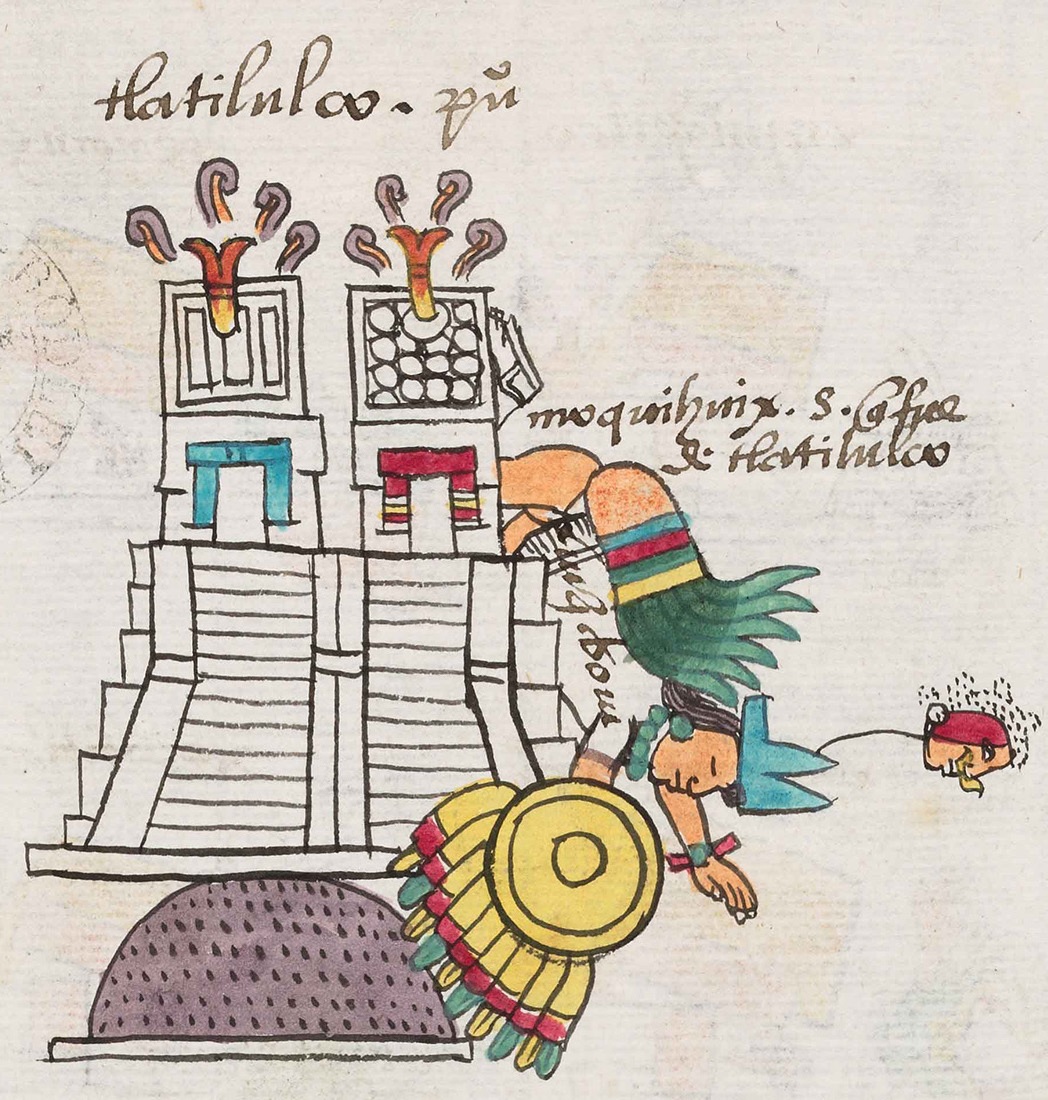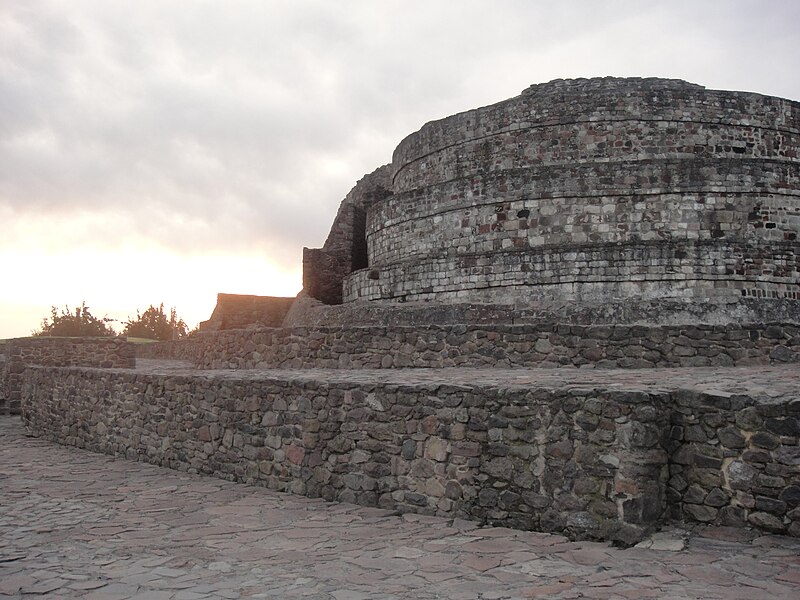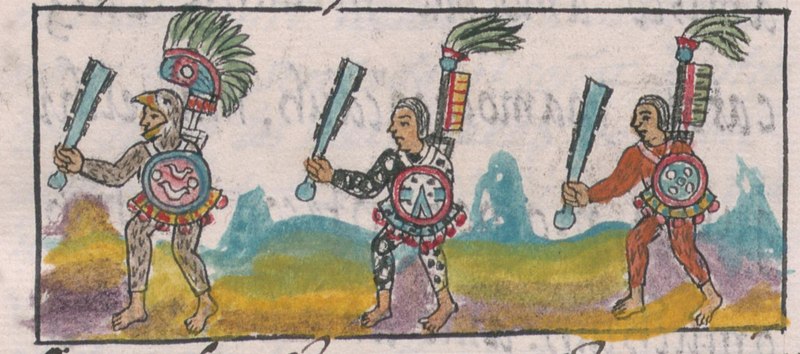 |
| Axayacatl |
Ruling Tenochtitlan
Tenochtitlan
was first among equals within
the Aztec Triple Alliance[i]. Power was held by a ruling class of
nobles where talent and birth were taken into consideration when choosing the
city’s ruler, the Tlatoani[ii]. The holder of the title was chosen
by both nobles and priests. The ability to command armies was one of the requirements
as ruler, as the Aztec nation was constantly at war.
The post of cihuacoatl[iii] was the second most senior post in the empire as the Tlatoani’s deputy and Tlacelael[iv] was holder of the post subordinate to four Tlatoani; Itzcoatl, Moctezuma I[v], Axayacatl and Tizoc. When the Tlatoani went to war the cihuacoatl was in charge of affairs at home. Tlacaelel strengthened the concept of the Aztecs as a chosen people, and elevated the god of war to head the pantheon of gods, and increased militarism. Tlacaelel is also alleged to have increased the propensity for human sacrifice in an attempt to stave off the natural disasters that became prevalent in Six Rabbit (1446)[vi].
‘I, Tlacaellel, would fain fire the brave-hearted
warriors and also encourage the cowards by rewards which are bestowed on them
for special deeds…..For after his return [from war], all will be given to him,
according to his deserts [sic], in reward for his exertions.’[vii]
To emphasise the position of Aztec nobility within the structure of society Tlacelael helped design and enforce sumptuary laws, prohibiting commoners from wearing items like lip plugs, gold armbands, and cotton cloaks. He also instigated a policy of burning the books of conquered peoples in an attempt to erase memories of a pre-Aztec past.
The huge expansion in Aztec possessions under Moctezuma I required new officials from the nobility to rule their new lands. Tlacaelel suggested to the Tlatoani that he;
‘Invite second-grade warriors into your royal
palace, who have merited reward on a lower scale. They must be granted the
right, after they have been selected by the generals, to wear the insignia, the
ornaments and the jewellery, which are the privileges of the highest
nobility….a man must have distinguished himself in battle and to have taken
prisoner some warriors.’[viii]
The hereditary principle became embedded in the system during the late 15th century. The calmecac schools were required to train more and more officials to take up the strain.
Tlatoani
 |
| Moctezuma I |
Ahuitzotl was born into the ruling class of Tenochtitlan, his date of
birth is unknown. He was the son of Princess Atotoztli II and her cousin Prince Tezozomac. Ahuitzotl was the youngest of three
sons and both his brothers, Axayacatl and Tizoc, ruled Tenochtitlan before him.
Ahuitzotl also had a sister Chalchiuhnenetzin[ix]. The boys were grandsons of Itzcoatl and
Moctezuma I, both rulers of Tenochtitlan, and would have all attended
the calmecac school in the Templo Mayor.
The sons of
the nobility were called Pipiltin
(the sons of Lords), the children of the Tlatoani inherited their parents lands
and lived in the palace. They did not automatically inherit their father’s
official position, but they had the edge on everyone else, based particularly
on services rendered or their feats in battle.
As a young
man Axayacatl’s military prowess brought him to the attention of influential
figures such as Nezahualcoyotl[x] and Tlacaelel. It also placed him in pole
position to be chosen as Tlatoani after the death of
Moctezuma in Thirteen Flint Knife (1440). Axayacatl was nineteen at the time.
His coronation war[xi]
against the Isthmus of Tehuantepec was a great success.
 |
| Puebla Valley |
Axayacatl’s
coronation war was followed by campaigns in the Puebla valley, on the Gulf Coast. In Seven House (1473) long standing
tensions led to Axayacatl being faced with a civil war on the island with
Tenochtitlan’s sister city Tlateloco. The two cities had been rivals for
decades.
Ahuitzotl
and Axayactl’s sister Chalchiuhnenetzin was married to Moquihuix, ruler of Tlatelolco. The couple had one child Axayaca, but Moquihuix
preferred the company of other women; according to the chronicles Chalchiuhnenetzin
smelled terrible and was thin and ugly. Moquihuix exiled her to live in a
separate palace while he amused himself with his concubines.
War
 |
| Death of Moquihuix |
Axayacatl
was angered by the public neglect of his sister and in Seven House (1473)
declared war on his brother-in-law. The fight was short-lived and ended with
Moquihuix being thrown from the highest pyramid in Tlateloco. An alternative version
of the facts had Moquihiux and his favourite dwarf threw themselves off the
pyramid in despair.
Calixtlahuaca was taken in Eight Rabbit (1474).
During the battle Axayacatl was wounded in the leg and he was never to fully
recover being left with a limp. A war against the inhabitants of the valley of Toluca was fought from the year Nine Reed to
Ten Flint Knife (1475-6) bringing towns such as Malinalco into the Aztec orbit. Further campaigns in the western
marches in following years were successful but these brought the Aztecs into
close contact with the Tarascans[xii] based to the west in what is now Michoacan.
 |
| Calixtlahuaca |
The
Tarascans were no pushovers and the Aztecs suffered as major defeat; out of an
army of 32,000 only 200 made it back to Tenochtitlan. Axayacatl made no further
attempt to attack the Tarascans remaining on the defensive in the west. Instead
he turned his attention back to the coast where he reconquered rebellious
towns. But it is clear that Axayacatl was embarrassed by this defeat; the power
of the Tlatoani depended upon his martial success. He wrote a poem;
‘I your grandfather
Axayacatl am ashamed, I have come to the end, I despise myself….
The true Mexica, my
grandsons, hold fast and stay in rank and file.
Their drums sound and their
shields remain firmly in their hand.’[xiii]
By the end
of his reign Axayacatl was a spent force. His previous conquests and the
support of Tlacaelel probably protected him from a violent death such as his
successor was to suffer.
.jpg/800px-Aztec_atl-atl_(Museo_Nacional_de_Antropolog%C3%ADa).jpg) |
| Altatl |
The Aztec’s
holy mission was to capture sufficient prisoners to sacrifice to the
ever-thirsty gods. Rewards for warriors were commensurate with the number of
prisoners they captured. In times of relative peace, in order to ensure
sufficient prisoners to satiate the gods’ appetite for blood ‘flower’[xiv]
wars between friendly nations were sometimes resorted to, allowing each side to
take away prisoners who were treated with great respect during their captivity
before being sacrificed for the greater good.
The Aztecs
were obsessed with ceremonies and the demands for luxuries employed therein
became unlimited. Vast wealth was expended to honour the gods who incited their
subjects to undertake further wars. The empire was ever-expanding[xv],
trading as far as the distant coast. Wars were also essential to secure
strategic trade routes for merchants or pochteca, so essential to provide the luxury
goods such as precious stones and bird feathers demanded by Aztec ceremonial.
The merchants also acted as spies and professional envoys.
 |
| Warriors carrying macahuitls |
Death in
combat was regarded as a means to ascend directly to sit at the side of god and
was one way to climb the social ladder. The soldiers used a variety of weapons
from slings and bows and arrows, lances and spears, stone knives, atlatl (spear) and macahuitls (a bladed obsidian sword)[xvi].
One Spanish chronicler claimed;
‘It is one of the most
beautiful sights in the world to see them in their battle array because they
keep formation wonderfully and are very handsome. Among them are extraordinary
brave men who face death with absolute determination.’[xvii]
Bibliography
The Ancient
Kingdoms of Mexico – Nigel Davies, Penguin 1985
The New
World – Nicholas Hordern, Aldus Books/Jupiter Books 1971
The Ancient
American Civilisations – Friedrich Katz, Phoenix Press 2000
Moctezuma
and the Aztecs – Elisenda Vila Llonch, the British Museum Press 2009
The
Illustrated Encyclopedia of the Aztecs and Maya – Charles Phillips, Hermes
House 2010
The Aztecs –
Richard F Townsend, Thames & Hudson Ltd 2010
Conquistadors
– Michael Wood, BBC Worldwide Ltd 2001
www.wkipedia.en
[ii]
‘He who speaks, ruler’, or
translated as Revered Speaker
[iii]
Or She-Snake or Snake Woman; a post meant to embody the female opposite of the
Tlatoani as the Aztecs believed that the world had been created from a male and
female principle that was reflected in real life. All the gods had wives or
sisters to echo this belief. The Tlatoani’s decisions had to receive the
consent of the She-Snake
[v]
Tlatoani of the Triple Alliance from 1440-69
[vii]
Ancient American Civilisations - Katz
[viii]
Ibid
[ix]
Little Precious Stone
[x]
Tlatoani of Texcoco
[xi]
All Aztec rulers had to prove their military capabilities after their
coronation
[xii]
Another empire built on a league between three cities
[xiii]
Ancient American Civilisations - Katz
[xiv]
‘Friendly’ battles
[xv]
And unsustainable in the long run
[xvi]
The Aztecs did not have metal weapons never having developed a method of
smelting iron, this, coupled with the lack of guns, put them at a disadvantage
to the invaders from the old world when they arrived in the early 16th
century
No comments:
Post a Comment
Note: only a member of this blog may post a comment.